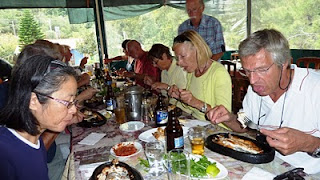 Kemer Cruisers Hiking Trip
Kemer Cruisers Hiking Trip

Wintering in Turkey Dec. 2010
This is now early December. Back home in Canada, the temperature is around the freezing mark, and parts of Europe are getting covered in snow from an early winter storm. But in this part of southern Turkey, we are still enjoying day-time temperatures of 20-plus Celsius, mostly clear blue sky, and mild evenings. On this refreshing Sunday morning of Nov 28, we are among a group of Kemer live-aboard yachties on a hiking trip up to the Chimera, which is known for its eternal burning rocks. Legend has it that Chimera was the offspring of two underground ceatures called Typhon and Echidna, a strange beast that breathed flames from its month, with a front of a lion, rear of a snake and a middle section of a goat. It eventually was killed by Bellerophontes, who rode the flying horse Pegasus. However, Chimera was breathing fire even as it was taking its last breath.
In reality, the Lycian Way (Likya Yolu) is a 500-kilometer marked trail that meanders through ancient Lycia, Mediterranean Turkey's mountainous Tekke region. Parts of the trail goes through lush pine forests, crosses clear mountain springs, and ascends into high peaks that provide breath-taking vistas of the Mediterranean. Some of the trails can be reached from Kemer within 30 minutes of car ride. Most Sundays we have such hiking trips that take us through several hours of moderately strenuous hiking, and sometimes at the end of the hike we reward ourselves with a lunch at a one of the fish restaurants which are nestled in the mountain.
Hiking is just one of the many activities available to us live-aboards here at Kemer Marina. The active yachties here organize events such as Turkish lessons, tennis training and tournaments, workout sessions, dances, concerts, dinners, movie nights, special celebrations … we’ve been so busy that we are pressed for time on boat work. It feels like being on a holiday that doesn’t end. Such is the life of living-aboard at Kemer Marina, which is well-known among cruisers as one of the best marinas in the Med. Surrounded by tall mountains and shielded from the worst prevailing southern winter winds, Kemer has a micro-climate that is warmer and milder than most other parts of the Med. When we were planning our destinations this year, we had two choices: keep sailing and leave the Med and perhaps cross the Atlantic; or hang around here for winter, for another year of sailing in the Med next year. After a summer of fairly active sailing and having visited all the Eastern Med, we decided to take it easy for the winter and to experience the live-aboard life style at a nice marina. So far we have not been disappointed.
The majority of the yachties here are retired couples, from UK, Switzerland, Germany, Norway, France, U.S., plus the odd Canadians. They typically come to their boat during the moderate months – spring and fall, and avoid the hot months of July and August. During the cruising season they cruise the Med and stay at anchorages or marinas. Most have been living this lifestyles for many years, and they have not run out of places to visit yet. We have also come across some young ‘retirees’, successful professionals who sold their business and started cruising in their large modern yachts. There are also the long-distance cruisers who are sailing on smaller budgets, but enjoying it just the same. You go to the marina’s pub, the Navigator, at happy hours, and you get to meet all types. It’s fascinating.
The yachties also host special events at the Navigator. We celebrate birthdays, anniversaries, and special occasion such as Halloween and more recently, the US Thanksgiving party there. We, the line dancing group, "performed" a few dances at the party and here's the video: http://www.sonovela.net/video/IFqSKWpS_dE/Kemer-Marina-Thanksgiving-2010.html
Comes December 6, we will be celebrating the St. Nicholas Day with the Swiss, (interestingly, St. Nicholas was born in Patara, an important Lycian city along Turkey's Mediterranean coast), and there will be parade and treats. For sure, there will be cookies. For days, air in the marina has been filled with aroma of freshly baked goods ..... hmm, yum!!!















































